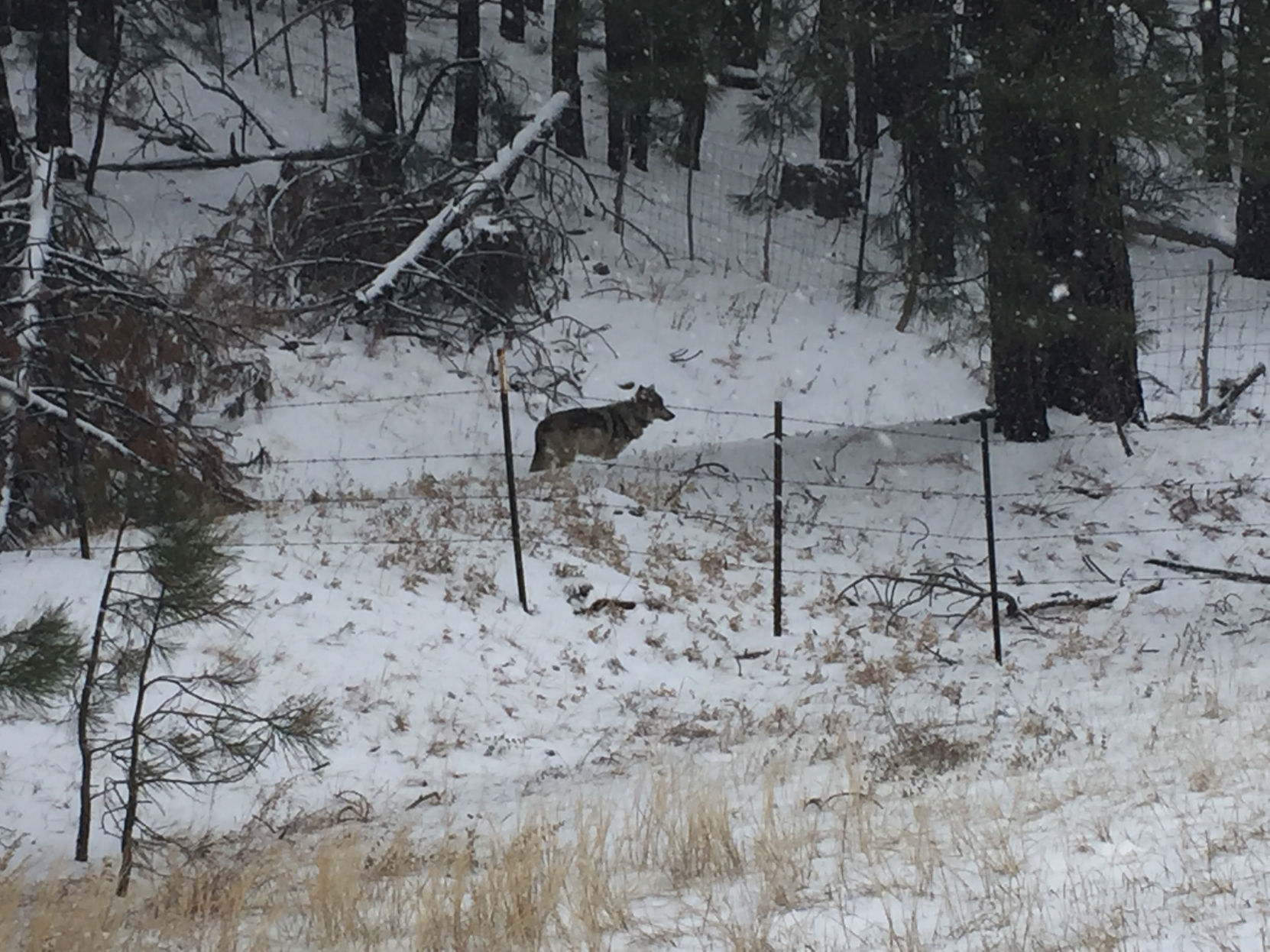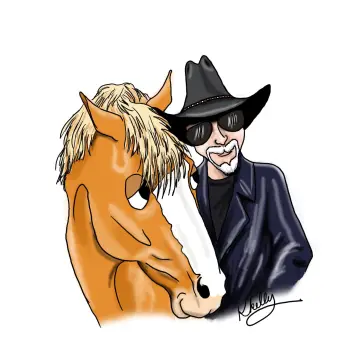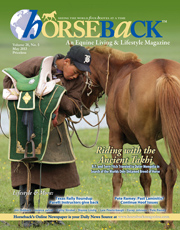by Peter Friederici as published on the Arizona Daily Sun
“We have no precise words for how the wolf was known and loved or feared…”

m1572 on his last day. Photo by Michele James
The story begins with a wolf standing by the side of the road. This isn’t the story you might think. There’s no helpless girl, no feckless pigs, no trickery. What there is, is hunger. Hunger for food, as always, and a hunger to roam. The woods are broad. Even though they are cross-stitched with fences and pocked with houses that must be avoided they extend on and on and they are rich with the tracks and scents of deer and elk and rabbits. The going is not difficult and it’s easy to find places to hide in rocky outcrops, thickets, copses of oak. It is only the roads themselves that are the challenge. It is second nature to figure out the trajectory and velocity needed to intercept a deer fleeing along a grassy meadow edge but the speed on roads is incalculable, incomprehensible, and the crossing is a gamble.
Or: the story begins with a young man, almost a boy still, on the side of the road. There’s no hunger, at least not of the deep-seated kind the wolf feels, the in-the-bones aching for protein. The suburbs are fat and if anything it is too easy to be sated: not only by food in a million varieties, but also by the sinuous winding of the well-kept roads, the smooth expanses of lawn, the houses kept up to a fare-thee-well, the friends and acquaintances who all seem to accept it as a given. It’s all too easy, too shiny, too manicured. No, this hunger is of a different sort. Call it a need for emotional protein.
In my case the result was a pickup truck, the smallest kind you could get, because in my particular Midwestern suburb a pickup didn’t belong and so it was a way of expressing that magic word west. Or West, specifically, meaning far enough west that things were no longer flat, manicured, predictable. And the pathway was those big ribbons of road, so well known and comfortable from all those days and nights spent traversing the broad avenues, the winding cul-de-sacs. You could merge onto one as if you were a piece of flotsam tumbling into a river from a creek, and not emerge from the steady current until hundreds of miles later. Merge is exactly right: on the interstate you can enter effortlessly not only into the flow of traffic but into a comforting anonymity, hiding in plain sight. Camouflaged and safe.
I remember the feel of those early days alone in Arizona, the sense both of boundless possibility and of getting further out on a limb, away from family, away from what I’d known. There were more ways than before that things could go right, and there were more ways that things could go wrong. At that time the story of Chris McCandless immortalized in Into the Wild had come out only recently, the tale of how one young man had gone Way Out West and ended up dead in the Alaskan wild. Dispersing from home—it seemed necessary, but treacherous.
For biologists, the idea is that species need to experience some genetic mixing, so in some species—especially predators—some of the young disperse to find their own place. It’s always a risky prospect full of grapplings with new and unknown landscapes. By October m1572 was traveling on his own, covering long distances on White Mountain Apache land. In November he headed west, onto the Coconino National Forest. This had happened before with individual wolves but only rarely.
It was a wolf, an animal I’d heard in Arizona before but never seen, and we were glad to see that it ran off from the road into the snowy woods, and not so glad to see that it was limping.
But this isn’t the story you might think, about an exciting wildlife sighting and some revelatory or even spiritual message one might draw from it. No, this is a story about how later that day m1572 was killed on the road, a failed dispersal by an animal that couldn’t quite manage the human-managed landscape. It’s a sad story, just as stories of young people who don’t make it through are sad. Though it’s worth noting that m1571 is still out there, at least as of the end of February, roaming with a female wolf from a different pack. So maybe it’s a story about hope too, hope that we can have a world where the young of all species can do the exploration they need to do and end up where they ought to be.
Categories: The Force of the Horse, Uncategorized









We can hope and pray all species can survive the destruction to the environment going on now.
LikeLiked by 1 person
Hopefully, this would give some readers a new insight into these wonderful wild creatures – especially after the article on wolf hunting in Alaska! There are so many dangerous obstacles for any wild animal today – just crossing a road shouldn’t be one of them.
LikeLike
This is the 20th anniversary of Mexican wolf introduction.
https://m.facebook.com/story.php?story_fbid=10156385787482878&id=24436227877
LikeLike
https://www.rockymountainwolfproject.org/ourpack?utm_campaign=CrowdFunding&utm_source=CrowdFunding&utm_medium=WesternWatershedsProject
LikeLike
This story could easily be about our native mountain lions too. Not long ago, I saw a young mountain lion that had been killed on a road in a remote area. It appeared that the youngster had probably been following its mother across the road. A very sad sad day for me and for mother nature.
LikeLike
From INDIAN COUNTRY TODAY
‘Don’t Let the Corporation Steal Our Land!’ Tlingit Elder Opposes Alaska Native Landless Bill
Frank Hopper • January 28, 2016
“The corporate system is based on profit only and worsens class differences between higher and lower income groups.
The ancient, traditional clan system, however, although not perfect, is based on community-building. One system separates, the other unites.”
For much of the year the jet stream brings one rain system after another to Southeast Alaska, feeding the largest temperate rainforest in the world, the Tongass, ancestral home of the Tlingit, Haida and Tsimshian Nations. Sitka Spruce trees shoot up 300 feet like skyscrapers above a diverse ecosystem of plant and animal life. For thousands of years the Native people lived in harmony with the forest, honoring and respecting it.
Then one day the Natives began mowing it down. During the 1980s the Natives clear-cut thousands of acres of old-growth rainforest in the Tongass, leaving behind only a hideous desert of stumps.
This was the result of an experiment in social engineering called the Alaska Native Claims Settlement Act or ANCSA. Now Alaska Natives in five communities who were left out of the original 1971 settlement are petitioning Congress to include them. And at least one Tlingit elder is speaking out against it.
Signed into law by Richard Nixon in 1971, ANCSA awarded 44 million acres of land and nearly a billion dollars to Alaska Natives. But the money and land were given to newly formed Native corporations. Tribal members got shares in these for-profit companies. The idea was for the Native corporations to regularly pay dividends to Native shareholders, increasing the economic well-being of the people.
The disadvantages of the corporate system soon became evident as the pressure to pay dividends forced Native executives to clear-cut much of the timberland they’d been given. During the 1980s, nearly 100,000 acres of old-growth rainforest were clear-cut.
The corporate system is based on profit only and worsens class differences between higher and lower income groups.
The ancient, traditional clan system, however, although not perfect, is based on community-building. One system separates, the other unites.
https://indiancountrymedianetwork.com/news/politics/dont-let-the-corporation-steal-our-land-tlingit-elder-opposes-alaska-native-landless-bill/
LikeLike
Living With Wildlife
Leanne Allison
The Bow Valley of AB, Canada is the busiest place in the world where people and grizzly bears still coexist. ‘Living with Wildlife’ is the story of how communities in the Bow Valley of Alberta, Canada have come together over the past 20 years to live with grizzly bears and other wildlife.
Partners on this project include The Calgary Foundation, Town of Canmore, Alberta Environment and Parks, Yellowstone to Yukon, Nature Conservancy of Canada, Canadian Parks and Wilderness Society, WildSmart and a handful of private donors.
LikeLike